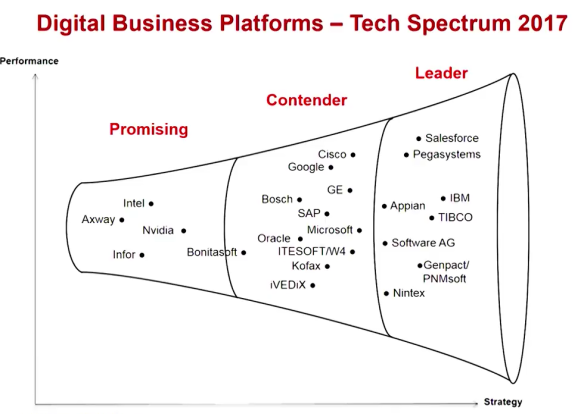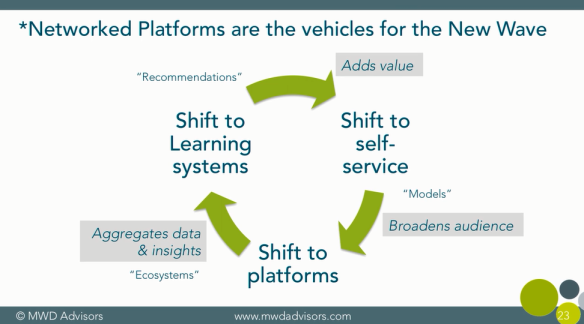Talks by Nathaniel Palmer, Jim Sinur, Neil Ward-Dutton, Clay Richardson kick off this bell weather event in the process industry. The big theme is digital transformation.
 Very interesting to see how all four play off of each other, and reflect a suprisingly lucid view of the trends in the process space.
Very interesting to see how all four play off of each other, and reflect a suprisingly lucid view of the trends in the process space.
Nathaniel Palmer (¤)
Kicked off the event and gives an excellent overview of the industry. Exponential organizations define the decade, and where is BPM in that? He has been promoting Robotic Process Automation as a key topic for a number of years now, which has finally come into popular usage. Who thought India would be a hotspot for this interest? Lots of kinds of robots: conversational assistants (Echo), robot lawyer accessed by web page, mobile robots that assist people in stores, industrial robots, etc. Tasks have different meanings and difference behavior based on the way that you interact with it.
We are going to need an army of robot lawyers to combat an army of robot lawyers for every transaction we do. Previous laws are based on a utility curve that assumes a limit to how much effort you would be willing to put in, but robots don’t care about that utility curve.
Biggest contribution is this architecture for a suite of capabilities needed for a digital transformation platform, which includes process management, decision management, machine learning and automation.
We should consider this architecture as a common understanding of where BPM is going.

Jim Sinur (¤)
BPM is morphing. Goal directed, autonomous and robots. 2017 Trends:
- Predictive apps get smarter. Predictive and cognitive. Decision criteria
- Big data, deep learning
- Machine learning is easy today; found 112 machine learning algorithms. Takes a lot of horsepower.
- Medium scale is deep learning on the fly and updating knowledge as you go.
- High cost is cognitive computing is expert and highly trained on specific topics. Watson takes a long time to train. Healthcare is a big focus.
- IoT: how to manage, how to talk. NEST protocol gaining steam. Autonomy at the edge, not just smart centrally. Things will have smarter chips. In the past predefined processes will give way to dynamic processes. Example, GM has paint robots that bid on jobs, and optimize order for work. Different booths have different quality ratings.
- Sales engagement platforms (SEP) and service engagement platforms
- Video enabled business applications. BPM is more about collaborative work management. All the fast upcoming company has included workflow. Training.
- Chat bots and digital assistants. Considers his Amazon Echo to be such a thing.
- Virtual reality will be more and more important. Gamification. Glasses now. Google glass a failure.
- Work Hubs and Platforms.
- Drones are being put to work. surveillance. Delivery.
- Block Chain – In production very few. Contained, constrained, small volume, real time. Builds. May require new kinds of chips. Security and integrity is crucial.
Digital business platform: (1) business applications (2) processes and cases, (3) machines & sensors (4) cognition and calculations (5) data and systems integration. Real live solution involves drone that flies checking pipeline status. Spectrum of vendors. Change management is a key part of all this. Digital transformation is mistakenly compared to enterprise re-engineering. Digital Identity is critical.
Digital DNA: goal driven processes, robots, cognitive, digital assistants, software bots, intelligent process, controllers, deep learning, learning, voice, RPA, sensors, machine learning.

Neil Ward-Dutton (¤)
The new wave of Automation
Context – A major shift in experience of automation. Shift in how we interact with machine. Used to shaping out live around automated system. Training ourselves. Automation lines are designed for the robots. But it is going the other way.
- way they interact with their environment
- flexing and recommending, and
- packaging work for us.
- First industrial automation (flour mill) 1785
- Learning system only since the 1960s/1970s.
Layers – Three layers; Interaction, Insight, Integration.
- Interaction is sensing and responding.
- Insight is about moving away from static analysis of plans, but dynamic reevaluation from moment to moment.
- Integration is about componentization, automate resources. Not just EAI, but more openness.
Drivers – why are we seeing these things now?
- rapidly evolving – fundamental assumption was that computing resourceses were scarce. Expensive, hard to get, and mistakes are costly. BUt that is changing.
- business pressures –
- Customer experience excellence. How to create customer journeys that are enticing.
- Decouple knowledge from labor.
- Perform at speed
- familiarity – automation, bots, recommendations
It is crazy that the people that turnover the most, need the least training and cost the least are the people who talk to the customers most.
Impacts
- Insight: some HR system that identifies people who are likely to leave, and what the cost of that person leaving would mean.
- Integration: Does RPA belong here? Primarily integration.
Follow the money: expert assistants (increase impact of experts), case advisors (make everyone as good as the best), task automators (highly procedural routine tasks). And personal productivity.
It is bullshit to say that a particular job will disappear — maybe tasks, but not entire jobs.
Your opportunity.
Layers: (see graphic at the end of section) highly automated tasks on lower levels. Sense and respond above that. Then human personal productivity assistants – useful but low value.
- Chatbots – text based or speech based interactions, but no real smarts.
- Recommendation services – expert, next best action
- Smart Infrastructure – maintenance, management
Virtuous cycle, three steps:
- Shift to self service in terms of access to tools. Integration tools. Process. Kanban kind of tools. Tools that can be used by a much broader audience.
- Shift to (network) platforms. Aggregates data and insights. IaaS was really about cost and scale. This is different. Shared, networked, cloud platform. Not about the underlying technology, but data and insights. If everyone has to build their own, they won’t have access to aggregated data. But the value of a networked cloud platform is access to data, aggregating insights, quicker.
- Shift to learning systems. Figuring out how to take recommendation services.
SnapLogic: integration assistant.
Boomie Dell StepLogic: operational data from customers history. Can identify customers that are struggling.
Clay Richardson (¤)
How to Survive the Great Digital Migration
Clay has a new startup: Digital Fast Forward and also advising at American University.
A poll found that digital transformation is the #1 priority for BPM. But the teams don’t know what to do. Prediction that 75% of BPM programs will fail. Referenced the World Economic Forum’s Fourth Industrial Revolution. Creativity used to be low on the list, now near the top. Companies are not seeing this yet.
Digital gold rush versus the digital drought. They get the technology part, but not the skill part. Less than 20% of companies have the skills.
AT&T’s competitors are not just Verizon and Sprint, but also tech giants like Amazon and Google. For the company to survive in this environment, Mr. Stephenson needs to retrain its 280,000 employees so they can improve their coding skills, or learn them, and make quick business decisions based on a fire hose of data coming into the company.
Strategies to address these: hire, reinvent, and outsource. Try to take all three.
Maintain –> waterfall, implement–>agile/scrum, experiment –> ????? (design thinking?) Actually very ad-hoc.
Design, Validate, Learn Check out Google design sprints. How do you move quickly into design sprints. How many are familiar with Objectives and Key Results (OKR)?
Not just what you learn, but HOW you learn it. Has to be interactive and immersive. Like a hackathon.
Digital innovation boot camp. 6 weeks in silicon valley. retrain to become digital experts. Put together for immersion. Real world experiences. Tripled the volume of digital innovation ideas. Accelerated speed to green light digital projects.
Incorporated ‘Escape Room’ concepts into training exercises that he ran. People love learning in interactive, immersive situations.
Digital platforms must evolve to support experimentation. AI, robotics, mobile, low code, IoT. Is going to have to bring rapid protoyping, OKR management, and hypothesis boards. Need the cycle of build, measure, learn.




Pingback: 6 Key Components Of A Digital Business Platform (DBP) - Adeel Javed
Pingback: Business Driven Software | Thinking Matters